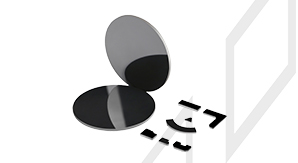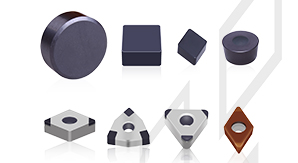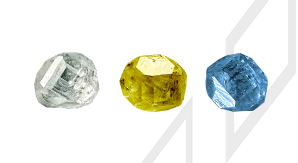The brazing technology of PCD cutting tool plays an important role in its use. High frequency brazing refers to the brazing method that uses the principle of electromagnetic induction to convert electromagnetic energy into heat energy in the solder and workpiece, heat the solder to the molten state, and then braze the workpiece together. The advantage of high frequency brazing is that it can be heated quickly, the dimensional accuracy of the workpiece can be ensured, the equipment investment is low, and the brazing process is easy to master.
The notes in the brazing process of PCD cutting tools are as follows:
1.Thermal stability
PCD is metastable at atmospheric pressure, and the critical brazing temperature of PCD cutting tool is about 750 ℃. At this temperature, the rate of diamond catalyzed by cobalt to graphite will be very high. The experimental data show that the exact critical brazing temperature depends on the type of PCD. In general, the critical brazing temperature decreases with the decrease of diamond grain size.
2.Thermal expansion coefficient
The material layer of PCD is brittle material. When the thermal expansion coefficient of material layer material and tool body material is too large, it will produce internal stress and may lead to brazing defects.
|
Materials |
Initial diameter/mm |
Diameter/mm at 730 ℃ |
|
PCD |
10 |
10.00317 |
|
WC-6%Co |
10 |
10.00425 |
|
WC-12%Co |
10 |
10.00477 |
|
Stainless steel 17-4PH |
10 |
10.00788 |
|
Stainless steel |
10 |
10.01256 |
|
Stainless steel |
10 |
10.01299 |
3.Tool groove design
If the tool head is to be suspended from the tool body, it is recommended that the length of the suspension be less than 100 μm to avoid cracks in the brazing process.
4.Brazing area
For brazing cutting tools, it is recommended that the brazing area (in mm2) is >100*f*ap. in order to ensure that the insert can bear the cutting load.
5.Solder
The temperature of high frequency brazing PCD cutting tool should not exceed 720℃, in order to avoid graphitization of diamond layer and thermal damage of diamond layer, which will affect the surface quality of PCD cutting tool and reduce its service life. Therefore, it is suggested that the low temperature Ag-based solder should be used in brazing PCD cutting tools, the melting temperature is about 680-705 ℃, the working temperature is about 690℃, and the shear strength is 250-300 MPa.
6.Flux
The flux can remove the oxide on the surface of cemented carbide and prevent it from oxidation during heating, which helps to better infiltrate the solder. It is suggested that the working temperature of the flux should be similar to that of the solder, and the initial working temperature of the flux is lower than that of the solder; for example, the melting point of the solder is 680-705 ℃, and the working temperature of the flux is 650-750 ℃.
7.Brazing holding time
Even if the diamond layer is kept constant for a long time at a relatively low brazing temperature, the diamond layer will suffer serious thermal damage. With the increase of brazing constant temperature time, the cobalt and its oxides on the diamond surface increase gradually. When the constant temperature time is extended to 60 s, wrinkles and black spots caused by oxidation will appear on the diamond grains, and the thermal damage of the diamond layer will be intensified. Thermal damage will affect the surface flatness of the diamond layer, increase the friction coefficient of the cutting tool rake, and then reduce the service life of the tool and affect the surface quality of the machined workpiece. Therefore, while ensuring the brazing strength, the high frequency induction brazing process of PCD cutting tools should adopt a shorter constant temperature time to ensure the performance of PCD cutting tools.
8.Interface finish
The degree of smoothness of the interface has a great influence on the wettability of the solder. The wettability of the solder at the interface is as follows: polished surface > grinding surface > fine sandblasting surface > coarse sandblasting surface. Because the smaller the brazing surface roughness is, the smaller the flow resistance of the solder is, the more fully the solder will be spread, and the better the wetting effect of the base metal will be.
To sum up, the main factors affecting the quality of PCD high frequency brazing are the type of solder, brazing temperature, brazing heat preservation process and so on. In the process of practical application, it is necessary to determine the brazing process according to different grades of PCD in order to obtain high quality brazing cutting tools.

CBN/DIA Superabrasive
Improve grinding efficiency to a new level
PCD Blank
Improve the comprehensive competition advantages of cutting tool manufacturer
PCBN Insert
Substantially improve cutting efficiency and tool life
HPHT Lab-grown Diamond
Protecting the environment and creating art and beauty with technology is the tireless pursuit of Funik